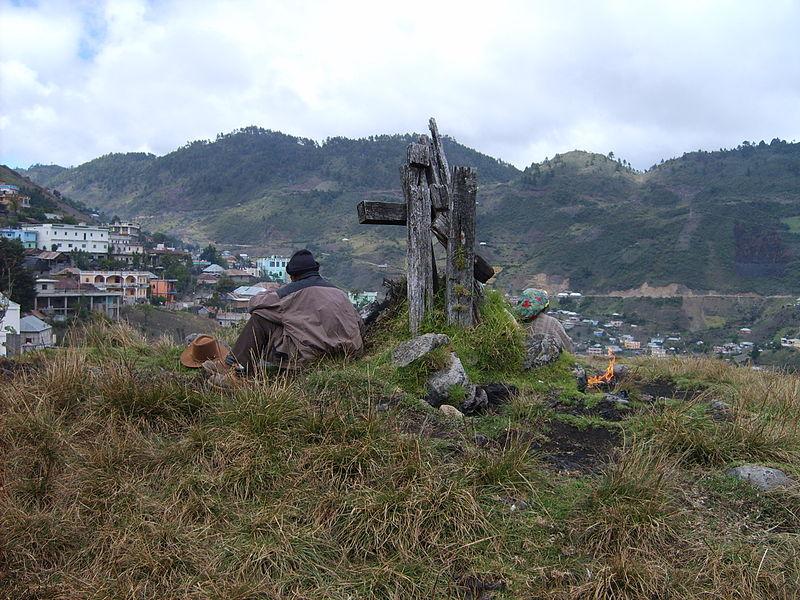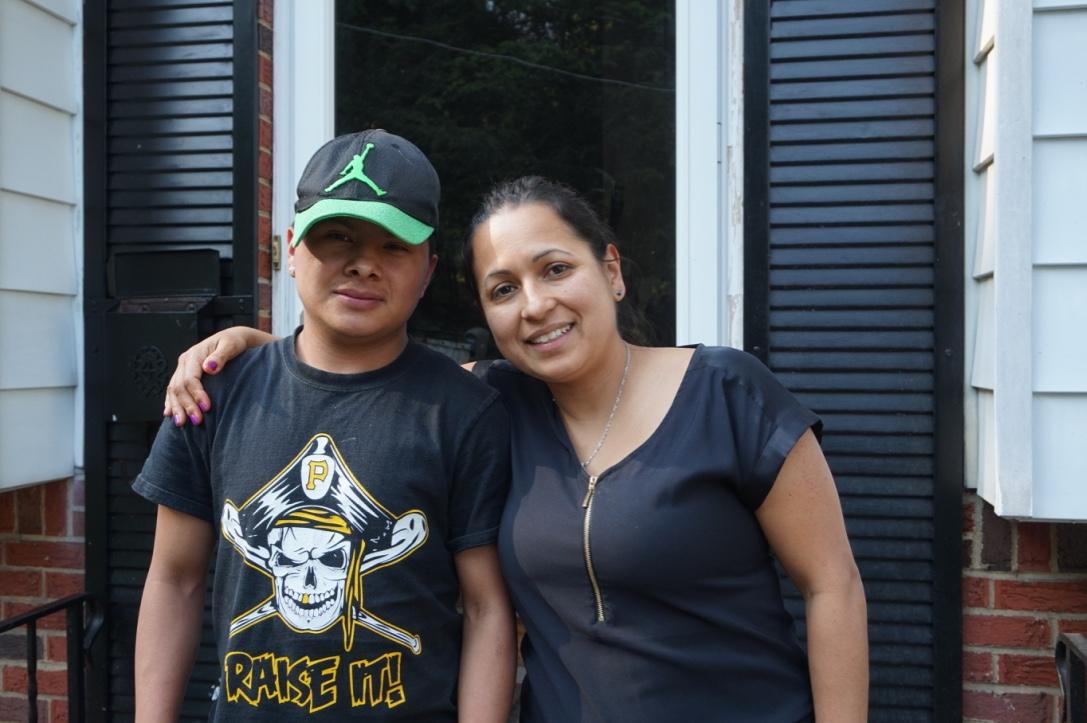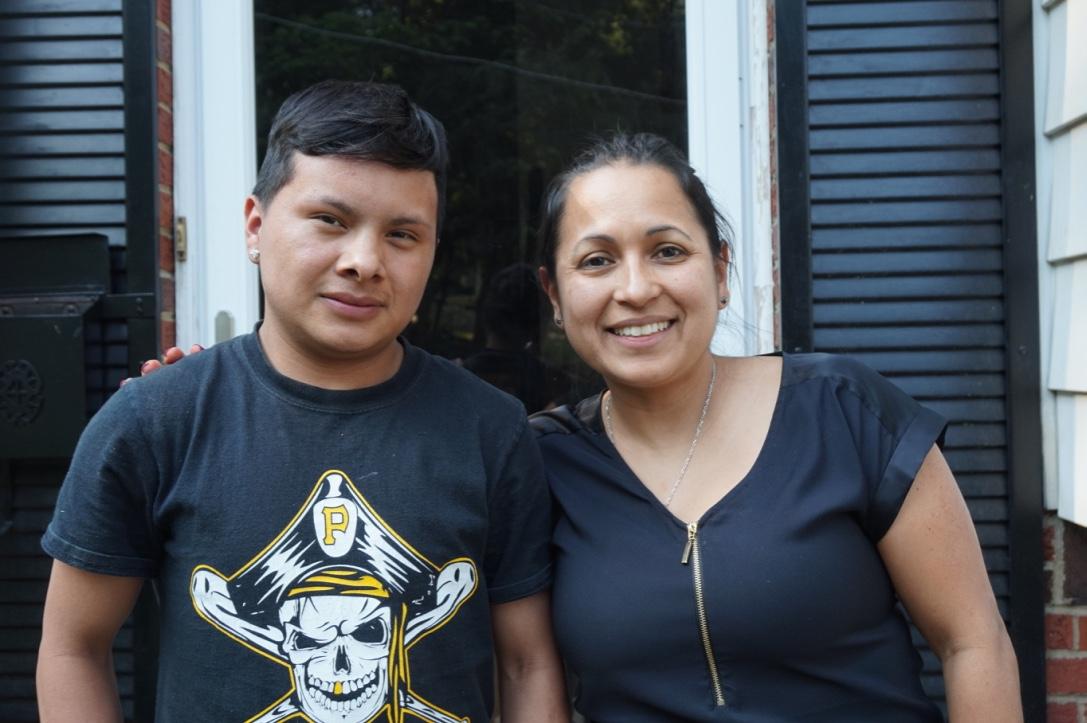It took a health emergency for this Guatemalan boy, who crossed the border alone, to see a US judge
Monica Ruiz and her foster son Bartolo pose in front of their Pittsburgh home. Ruiz says part of Bartolo’s challenge is to learn to become a teenager again. “They've had so many adult responsibilities for so long,” she says.
To see Bartolo now — happy, healthy, slurping a Go-Gurt in an English language class — you’d never know what he’s been through since he left his town of San Mateo Ixtatán in northern Guatemala four years ago.
He grew up working in the fields alongside his father, occasionally selling items in the market to help support his parents and siblings. But weeks after turning 16, he set out to the US, joining tens of thousands of other undocumented, unaccompanied minors fleeing poverty and violence in Central America.
“I wanted to come here. There, there isn’t money, I couldn’t get money. That’s why I came here,” Bartolo says. Because he is worried about backlash and he is a teenager, we are only using his first name.
He was a child when he crossed the border in Texas in late 2013. He’d been traveling for months.
“I passed through the desert. I wanted to come here. But yes, there are people who say people die in the desert or they get caught. So, yeah, then I got scared,” he says.
Because he was a minor and from Central America, US Customs and Border Protection agents didn’t turn him away when he reached the border. Rather, immigration officials first sent him to a detention facility in Florida.
What happened next is a controversial practice that has been in place for years. After a few weeks, the US government placed him with a cousin who agreed to be Bartolo’s sponsor, to take care of him for an undetermined amount of time. In the meantime, the government began the process of sending him back to Guatemala.
Also named Bartolo, his cousin was in his 20s and lived in a suburb outside of Pittsburgh. He, too, was undocumented.
Read more:Are the unaccompanied children crossing into the US refugees or migrants?
From October 2016 through last March, almost 35,000 unaccompanied children were released to sponsors, according to the Office of Refugee Resettlement. The year before that, more than 50,000 children were released to sponsors.
Critics say that this policy of placing kids with sponsors encourages children to take the perilous journey north to the US. Others argue that there isn’t enough scrutiny of sponsors, that the US government could be placing children like Bartolo in dangerous living conditions.
Older Bartolo had been in the US for a decade. He worked at a restaurant, sent money home and periodically returned to their hometown and then illegally came back to the US to work again. Younger Bartolo moved in with his cousin to do the same. They lived in a house managed by the owners of the restaurant.
Joyce Gallagher Ramirez, the immigration lawyer who ultimately represented the younger Bartolo, has seen many of these kinds of setups — kids, houses, restaurants — over the past two decades.
“The owners or managers of the restaurant will rent an apartment, and there is usually quite a few people living together in the house,” she says.
In this case, it was about a dozen men. Bartolo says it wasn’t that bad to join his cousin. But others who saw the house say it was kind of rough.

Grace Muller worked with Casa San Jose, an organization that helps mostly Spanish-speaking immigrants in Pittsburgh. She visited the house where Bartolo was staying. Some men, she says, slept on lawn chairs and others on camping cots. The cousins lived in the unfinished basement.
“In Bartolo and Bartolo’s room, it was just kind of — a mattress. I don’t know if there were even sheets on it,” she remembers. But “that was a lot more money than they were making in Guatemala and they could eat whatever Chinese food they could get left over at the Chinese restaurant, so for them, they thought it was a pretty good deal.”
Young Bartolo made his way making less than minimum wage — what he made varied from week to week and he took whatever the restaurant gave him. He worked 12 hour days, six days a week. Once a week, he sent $100 to his family. In Guatemala, that money went far. He says in his hometown, most workers made the equivalent of about $28 dollars a week.
“People need the jobs, and the employers need the employees. It’s not a good situation for either side, but that’s how it’s been for years,” says Gallagher-Ramirez, the immigration attorney.
Since Bartolo arrived, the numbers of children crossing the border alone have increased. Just over 38,000 came in 2013, and nearly 60,000 arrived in 2016, according to US Customs and Border Protection. But this is not a new phenomenon.
“My husband came here when he was 15 from Mexico and did the exact same thing,” says Gallagher-Ramirez. “It’s almost like a rite of passage. The boys just kind of grow up knowing or believing that at some point, it’s going to be their turn to go to the United States to work to support their families.”
To be clear, it’s not something every boy in Central American does. While the number of undocumented children has risen, it’s still only a small percentage of children from Mexico and Central America who have made this journey. But those who do, face significant challenges.
Read more: Why would any parent send their kids on the deadly trip to cross the Mexico-US border? Here’s why.
Bartolo only spoke his native Chuj language when he first arrived in Pittsburgh in late 2013. Once he settled in, he started picking up Spanish and attending church. He connected to services via Casa San Jose, which is where he met Muller. She was working mostly with Central American teenagers who had come here on their own, many fleeing violence back home.
“The summer I met Bartolo, that was the biggest wave we’ve had,” Muller says. “And that was a wave nationwide. We had so many cases, we didn’t know what to do with them.”
“Those kids needed everything. They came with just — no clothes. The houses they were staying in had no food. A lot of times, the people they were staying with were vaguely related to them.”
Odds were, Bartolo was just going to work and send money home for the foreseeable future, just like his cousin and so many others had. It wasn’t clear when he would hear from immigration authorities again. There was a backlog of about a year and a half of unaccompanied minors’ cases.
And then one morning, about a year after Bartolo first arrived in the US, Muller got a text message.
“Younger Bartolo had some sort of growth or bubble on his back,” Muller says. “And I was like, ‘Listen, I’m not there and I don’t know anything about back bubbles or growths, and you need to see a doctor about that,’” she says.
It was the kind of moment an undocumented immigrant dreads: coming face-to-face with the system. If they could have, the cousins would have avoided it. They didn’t have money to pay for hospital bills. But they knew it could be a matter of life or death. So, the two Bartolos went to the hospital.
At the hospital, it turned out a lot was wrong. The bubbles were related to Pott’s disease or spinal tuberculosis. Bartolo also had a potentially fatal heart murmur. And he needed glasses. At 5-foot-3, he weighed 90 pounds. Hospital staff wrote in his records that he was possibly malnourished.
But getting treated was tricky — he was a minor and even though the US government had placed him with his cousin when he entered the country, his cousin wasn’t actually his legal custodian. No one was.
“So here he was, a kid who is 16, and he can’t sign the papers, he can’t make informed decisions about his own health care. But no one else could either,” says Muller. “No one seemed to know what to do to handle a kid who doesn’t have health insurance, doesn’t speak English and needed a lot of follow-up care.”
It was a case for the courts. Specifically, for Eleanor Bush, a judge of the Allegheny County Court of Family Pleas. Bush isn’t an immigration judge, but she ends up handling juvenile migrant cases because there isn’t anywhere else for unaccompanied minors to go. Judges like her can rule on custody issues, and they can make recommendations to the federal government. In this case, she recommended Bartolo try to stay in the US legally by applying for Special Immigrant Juveniles status.
“That category, Special Immigrant Juveniles, applies to children who have been abused, neglected or abandoned by one or both parents, and that abuse could have happened in the country that the child came from, or it could be something that happened here,” Bush says.
Nearly 9,000 children were approved for this status in 2015 — but the backlog is so extensive that the State Department said last year that it may be months or years before all of those approved receive green cards or legal permanent resident status.
Based on a judge’s findings, any child for whom it’s not in their best interest to return home can qualify for SIJ status. Violence, if perpetrated by parents or encouraged by parents, can qualify a child — but this is determined by judges. And something specific like illness that hasn’t been attended to or detected can be considered neglect.
Bartolo had never seen a doctor before arriving in the US. That was normal back home, where the closest doctor was five hours away. But here, that could be considered neglect.
“I am a state court judge in the state of Pennsylvania, so I need to apply Pennsylvania law to the situations that I see,” Bush says.
But because he was a minor, Bartolo’s parents still needed to be involved. Which meant overcoming a language barrier. Even with a translator, there aren’t words in the dialect of Chuj Bartolo’s parents speak that translate to the words they were hearing from Judge Bush.
But they got through the conversations. In the end, the court placed him in an orphanage. As a ward of a state, he was entitled to medical care. And immigration authorities approved his SIJ status, which meant he could apply for a green card.
“He’s probably the only case that I can recall with the unaccompanied minor cases that’s really turning on a medical problem, a medical issue,” says Gallagher-Ramirez, who represented him. “And, for sure, if his situation hadn’t been detected and treated, and he had been sent back to Guatemala, he would have died. There’s just no two ways about that.”
The people who know him all say the same thing: His illness ended up being kind of lucky. He underwent treatment for the Pott’s disease and still gets follow-up care. Doctors still monitor his heart. He gained weight. And he got glasses. His special immigration status got him a work permit, a social security number and permission to stay in the US.
That was two years ago. Bartolo still spends time with Muller, whose advice to go to the hospital might have saved his life.
“I wouldn’t call it a friendship. I’m an adult woman, and this is a teenager,” Muller says. “But I care a lot about him, and I still try to spend a lot of time with him.”
Once a month, she takes him out for breakfast. When she shows up to get him, he’s ready and excited to see her and has a lot to say. At a diner, they catch up. She asks about the cousin he lived with when he first came here — the older Bartolo has since returned to Guatemala. They talk about music, telenovelas and weekend plans.
“Yesterday, I came home from work and I started watching Netflix, and I didn’t have dinner,” she tells him on a recent outing. Bartolo laughs.
“Yes, that happens to me too, when I like a movie,” he says.
These days, Bartolo lives with a foster family. Once a week, his foster mother, Monica Ruiz, buys him an international calling card. He uses it to call his family back home in Guatemala. He gets updates on his siblings. Then, when he hangs up, he’s back to his new reality in Pittsburgh — far in every way from the poor, rural Guatemalan town where he spent the first 15 years of his life.
He’s far from the dusty journey he took through Mexico to cross the border into the US. And far from the flophouse where he lived when he first came to Pittsburgh. Ruiz’s house is comfortable, in a suburban part of the city where the pantry is always stuffed with food and Bartolo has everything he could possibly want.
“I’m used to them,” he says. “They are my family. They take care of me like a son.”
“Now, he’s like any of my other kids,” Ruiz says. “Anything he needs, anything he wants — ‘I need this, I need that, I’m going here, I’m going there.’”

And that’s meant some growing pains as Bartolo has relearned how to be a kid — and Ruiz has learned how to parent someone like him. A few years ago, she and her husband signed up to foster unaccompanied kids coming from Central America. The first was a 4-year-old; she was quickly reunited with her family. Then they got Bartolo. He was 17 but had been on his own for a while. His closest friends are kids just like him, who came to the US by themselves and are also living with foster families.
Ruiz gets it. She was born into a Latino family, and her husband came to the US alone from Mexico when he was 17. She has watched Bartolo and his friends change. When she first met them, they were more like men than boys because of what they’d been through.
“Right now, they have an opportunity to be teenagers and they’ve never been teenagers. They’ve had so many adult responsibilities for so long that this is an experience that they’ve never had, and it takes them a while to adjust to it,” Ruiz says.
“Not having to work all day every day, getting to stay at home, play video games, go to the mall, go see a game, go swimming, go to the park,” she says. “What we take for granted.”
It makes Ruiz happy to see Bartolo be a kid, but his family in Guatemala still expects him to work and send money home. After all, that’s why he left. For more than a year, he couldn’t really work because of his health and legal issues and school. And it turns out, he likes his new life.
“Here, I want to have everything — I want to buy a house, a car, all of that,” Bartolo says. “And then Guatemala — well, I’m forgetting that. But my family lives there so I still have my heart there.”
As she makes dinner, Ruiz says when he first moved in, Bartolo never asked for anything. Now, his tastes have changed.
“He’s getting a little too big for his britches,” she says. “He’s wanting really expensive things and, I mean, we’re not wealthy. And I don’t believe in spending $150 on a pair of shoes. I’m not that way, even if I was wealthy.”
At the same time, like her two other children, she wants him to want those things and to do better for himself.
“I want him to be successful here. I don’t want him just to get by. The same way I push my other kids, I push him, too. ‘OK, that’s great, but what’s the next thing? How can we do more?’”
Bartolo has come a long way since that day he crossed the border in 2013. There’s nothing certain about this future, but it’s a lot more secure than it was in those days when he was sick, undocumented and far from home.
Bartolo is still waiting for his green card, which will give him legal permanent resident status in the US. He will turn 20 in July, but he can stay in the foster system until he turns 21. He’s gained weight and is still getting treatment for his health problems including the heart murmur.
